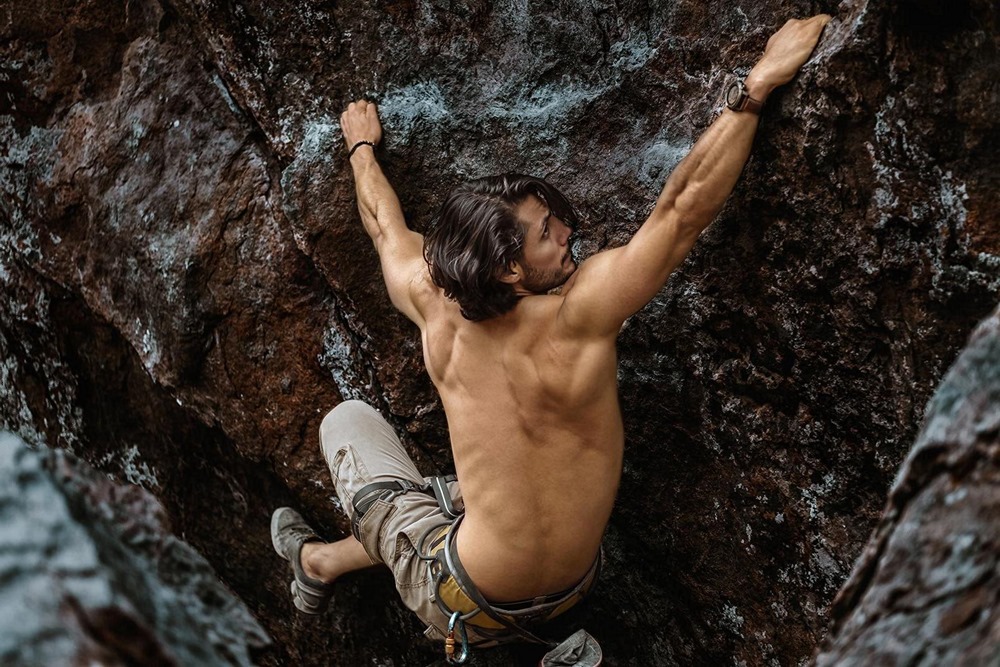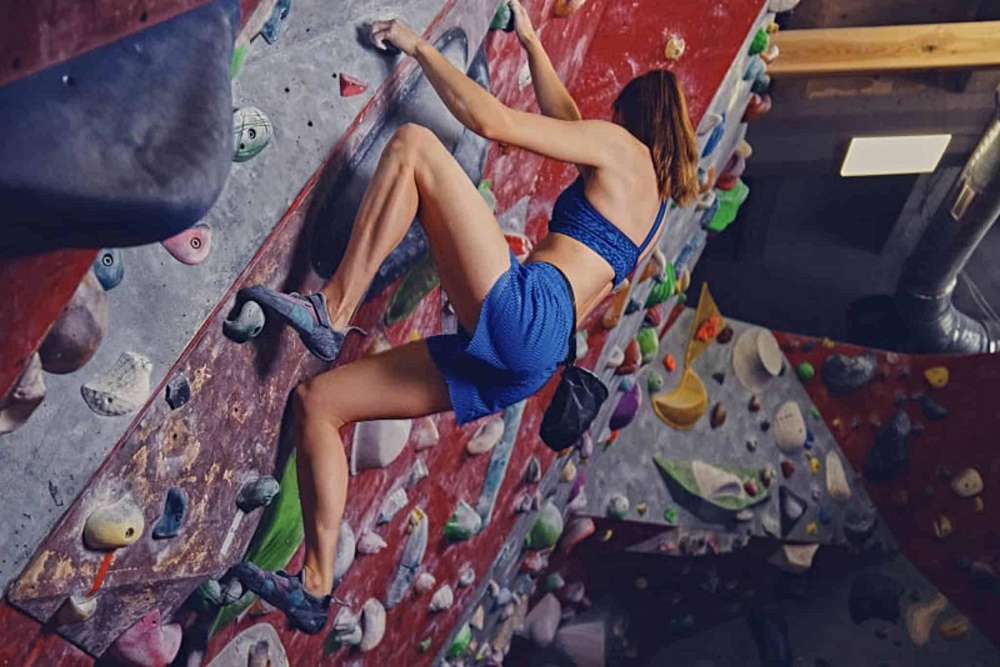Last Updated on: 18th December 2024, 12:32 pm
Rock climbing is a comprehensive workout that engages both the mind and body. It has evolved from a niche activity into a popular fitness regimen available in gyms and climbing centers worldwide. This sport combines strength training, endurance, and flexibility exercises, making it an effective full-body workout.
Originating from mountaineering, rock climbing has developed into a sport with various disciplines like bouldering and long multi-pitch climbs. It offers significant physical and mental benefits, making it an appealing choice for those seeking a dynamic fitness approach.
Rock climbing engages nearly every muscle group. Climbers use their arms and legs to ascend, while core muscles maintain balance and stability. This coordination not only builds muscle but also enhances mental focus, making rock climbing a holistic exercise option.
The Anatomy of Rock Climbing

Understanding the Muscles Engaged During Climbing
Rock climbing involves a complex network of muscles:
- Latissimus dorsi, biceps, and forearms: used for pulling movements.
- Legs, particularly the quadriceps and calves, push you upwards.
- Small stabilizing muscles around shoulders and hips: important for precise movements.
The Role of Core Strength in Maintaining Balance and Stability
The core is crucial for balance and stability, enabling climbers to maintain challenging positions. It includes muscles around the trunk and pelvis, all working together to keep you steady.
The Importance of Grip Strength and Upper Body Conditioning
Grip strength is essential for climbing, affecting the duration and quality of your climb. Upper body conditioning strengthens arms and shoulders, ensuring secure grips. Conditioning these muscles can be the difference between completing a route and falling.
In summary, rock climbing is a comprehensive fitness activity, engaging various muscles, requiring core strength for balance, and relying on grip strength and upper body power.
Cardiovascular Benefits of Rock Climbing

Elevating Heart Rate for Cardiovascular Health
Rock climbing elevates your heart rate, similar to traditional cardio exercises. The continuous movement ensures your heart works efficiently, strengthening the heart muscle and reducing heart disease risk.
Comparison with Traditional Cardio Exercises
Unlike repetitive exercises like running, rock climbing offers a dynamic challenge. Each climb is unique, engaging the body and mind, keeping workouts engaging and less monotonous.
Boosting Endurance and Stamina
Rock climbing builds endurance and stamina through sustained effort. Climbers learn to manage energy efficiently, improving performance in other activities.
Incorporating rock climbing into your routine strengthens the heart and builds endurance, making it a valuable addition to any fitness plan.
Mental Health and Cognitive Benefits of Rock Climbing

Psychological Advantages: Focus, Problem-Solving, and Stress Relief
Rock climbing is a mental workout, enhancing focus and problem-solving as climbers navigate routes. This concentration provides stress relief, offering a form of moving meditation.
Mindfulness and Mental Health
Climbing requires full presence, promoting mindfulness linked to improved mental health, reducing anxiety and depression symptoms.
Building Confidence and Overcoming Fears
Climbing builds self-confidence and helps overcome fears. Each climb challenges physical and psychological limits, boosting self-esteem and empowering climbers.
Rock climbing offers mental health benefits, enhancing focus, problem-solving, and stress relief, while promoting mindfulness and confidence.
Flexibility and Injury Prevention in Rock Climbing

Enhancing Flexibility and Range of Motion
Rock climbing promotes flexibility and range of motion. Climbers reach and stretch, making their bodies more pliable, reducing strain risks.
Preventing Common Climbing Injuries
Proper technique and conditioning prevent injuries like tendonitis and shoulder issues. Building strength in supporting muscles is crucial.
The Critical Role of Warm-Up and Cool-Down Exercises
Warm-up exercises prepare muscles and joints, reducing injury risk. Cool-down exercises help reduce muscle stiffness. These practices are essential for preparation and recovery.
Integrating these elements enhances performance, prevents injuries, and ensures a fulfilling climbing journey.
Nutrition and Hydration: The Climber’s Edge

Optimizing Performance and Recovery Through Nutrition
Nutrition is key for performance and recovery. Carbohydrates provide energy, while proteins aid muscle repair. Balancing these nutrients ensures energy supply and aids recovery.
Hydration Strategies for Peak Climbing Performance
Hydration is crucial. Dehydration affects strength and focus. Climbers should drink water regularly and replace electrolytes lost through sweat using:
- Electrolyte-replenishing drinks
- Snacks with sodium and potassium
Fueling Your Ascent: Foods and Supplements for Climbers
Climbers need portable, nutrient-dense foods like:
- Nuts, seeds, and energy bars
- Bananas and dried fruits
- Lean jerky or almonds
Supplements like omega-3 fatty acids and vitamin D support health and recovery.
Smart nutrition and hydration practices enhance performance and recovery, preparing the body for climbing challenges.
Getting Started with Rock Climbing

Tips for Beginners on How to Get into Rock Climbing
Start by visiting local climbing gyms and talking to experienced climbers for guidance on the sport.
The Importance of Professional Instruction and Finding the Right Climbing Gym
Professional instruction is essential for learning proper techniques and ensuring safety. Choose a gym that caters to beginners and offers varied routes.
Safety Equipment and How to Use It Properly
Essential gear includes:
- Helmet
- Harness
- Climbing shoes
- Belay device
Learn to use this equipment correctly for safety.
Setting Realistic Goals and Tracking Progress in Rock Climbing
Set realistic goals and track progress. Start with simple climbs, increasing difficulty as skills improve. Celebrate achievements and learn from setbacks.
With the right approach, equipment, and guidance, anyone can start rock climbing. Begin your journey today.
Conclusion
Rock climbing is a transformative activity for body and mind. It combines physical challenge with mental engagement, fostering growth and resilience. This guide has explored the benefits of rock climbing, highlighting its role in a balanced, healthy lifestyle. Let the climb inspire you to reach new heights.

